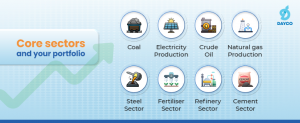Core Sectors In India And How They Impact YourPortfolio
![]() April 29, 2024
April 29, 2024
![]() 0 Comments
0 Comments
Four or five months back, India was standing on the brink of a coal shortage. For a country like India, where 70% of the energy needs are met by coal, the looming shortage rang alarm bells across the country. But why did every industry across all the verticals panic? What’s so dangerous about coal shortage? It’s because the coal sector is a sector upon which most industries depend. No matter which industry a company is associated with, it invariably requires electricity to run properly. There are some industries - like the Aluminium industry - that will be forced to stop production in the event of no coal supply. Thus, the coal industry sustains companies across almost all industries. Such industries that form the basis of other industries are called the core industries.
List of Core Sectors In India
As per the Office of Economic Adviser in India, there are eight sectors that are considered core. 40.27% of the weightage in the Index of Industrial Production (IIP) comprises these core sectors. These eight core sectors are -
- Coal
- The electricity production sector
- The crude oil sector
- The natural gas production sector
- The steel sector
- The fertiliser sector
- The refinery sector
- The cement sector
Core Sectors and Your Investment Portfolio
The economic condition in a country is shaped by core sectors. Hence, the performance of the equity market and any other investment instrument that is somehow connected with the core sector is impacted - either negatively or positively - by the core sector. You, as an investor, must stay abreast with how the core sectors in the country are performing. You have to optimise your portfolio based on the evolving performance of the core sectors.
Even if you haven’t invested in any core sector stocks, the stock prices of companies in other secondary sectors can be affected by the core sector developments. Below is a case study that explains this in detail.
Case Study: Rise of Crude Oil Prices & the Fall in the Price of Asian Paints
Back in 2022, the crude oil price was falling on a consistent basis. And then the Russia-Ukraine war started in February 2022. The price of crude oil soared sharply after that. In May, Brent crude touched $123 from the low of $78 in January. Now, if you see the historical price chart of Asian Paints, you’ll see a clear inversely proportional connection between the prices of crude oil and Asian Paints. In May, when the crude oil price touched $123, the price of Asian Paints nosedived to Rs.2834 from the high of Rs.3576 in January. But why did this happen? It happened because crude oil-based elements constitute 30% to 40% of the raw materials paint companies use. Hence, an increase in the price of crude oil means an increase in the raw material price for paint companies like Asian Paints, directly impacting their revenue. This is why people started panic-selling Asian Paints stock to avoid a sharp fall in their portfolio. (However, that’s not a good practice. But let’s talk about that some other day.)
Core Sector Companies and the People Who Invest in Them
The example we just gave shows how developments in the core sectors can indirectly impact companies that aren’t in the core sectors. But what about those investors who are invested in companies that fall under a core sector?
The other name for the core sector stocks is ‘key infrastructure sector’ stocks. As you can understand from the name, the stocks of core-sector companies contribute to the infrastructure development in India. And an uptick in the infrastructure and manufacturing sector, in turn, results in the improvement of the country’s GDP.
Hence, a sharp or consistent increase in the Index of Industrial Products is good news for the country's GDP. So when you hear news like “Core sector output for the quarter has increased”, it’s likely that you will see your portfolio perform well as well.
However, keep in mind that a rise in IIP does not mean that all of the core sectors are performing well. Even in the event of a sharp rise in IIP, it is possible that one or two among the eight core sectors might show poor performance.
Rise In Core Sector Output Indicates a Rebound In the Stock Market
Since an uptick in infrastructure development marks a rebound in the economy, the rise in core sector output indicates an improvement in the country's economic condition. Hence after a slump, when the output from sectors like cement or steel starts increasing, it can be a reliable indicator of a stock market turnaround.
Privatisation of Companies In the Core Sector Can Be a Big Opportunity for Investors
India has a specific advantage when it comes to investing in core sector companies. Most core sector companies in India are nationalised. And the Indian government has made it a point to privatise these core sector companies. This decision can open a new chapter in the history of core sectors in India. The already smart and successful core companies like ONGC or NMDC will become smarter and more successful once privatised. Access to newer technologies like AI and ML will propel these companies towards greater triumph. It’s now time to keep the stocks of companies in the core sector on your watchlist.
Bottom line India’s economic backbone is made up of companies in the core sectors. Even though the world bank has decreased India's growth projection to 6.6%, it is much better than established countries. At a time when the world is scared of a financial winter, India’s core sectors can help Indian investors to keep their portfolios green.
If you have a question, share it in the comments below or DM us or call us – +91 9051052222. We’ll be happy to answer it.
Share With
I'm a cool paragraph that lives inside of an even cooler modal. Wins!
Are you sure?
In case you didnt know, you can open your account online within 24 hours. Offline account opening takes up to 4 working days. If you wish to open your account offline, fill and sign the forms using a black/blue ballpoint pen. Please fill in the email and mobile number of the applicant to avoid account opening delays.
Enter Password
Please enter your details and password
New to Dayco?
Enter Password
Please enter your details and password
New to Dayco?
Filing Complaints on SCORES (SEBI) – Easy & Quick
- Register on SCORES Portal (SEBI)
- Mandatory details for filing complaints on SCORES:
- Name, PAN, Address, Mobile Number, E-mail ID
- Benifits:
- Effective Communication
- Speedy redressal of the grievances
Thanks !!
Your details were successfully received.

Thank you for Your Feedback!
Our Team is working constantly on improving our user experience and your feedback really means a lot.
Thanks !!
App Link Send to your mobile number successfully.
Thank You
All your Questions have been recorded
Thank You
All your Questions have been recorded
Thank You!
Thank you for your response. We'll get in touch with you at the earlisest for your investment planning needs
NEXT
Thank You!
Thank You for your interest in our Moderate Equity Portfolio. Please find below the credentials to track this portfolio:
User ID: mockmod@daycoindia.com
Password: abcd@1234
Portfolio Tracker
Please Read!
Risk profiling is crucial for identifying and managing potential risks in investment decisions. Please carry out your risk profiling before making any investment decisions.
Complete Risk Assessment Now
Thank You !!
Please enter your details to download/print the report
Thank You !!
Please enter your details to download/print the report
Thank You !!
Please enter your details to download/print the report
Thank You !!
Please enter your details to download/print the report
Thank You !!
Please enter your details to download/print the report
Set Your Goal
Please Select an option from below
Set Your Goal
Please Select an option from below
Thanks You !
We appreciate your interest in our services. Our team will be in touch with you shortly.
CloseSet your Goal
Please enter your details in the fields provided
Thanks You!!
Calculation report has been sent to your mail id successfully
Clear form?
This will remove your answers from all questions and cannot be undone.



 Book Appointment
Book Appointment









Leave a Reply